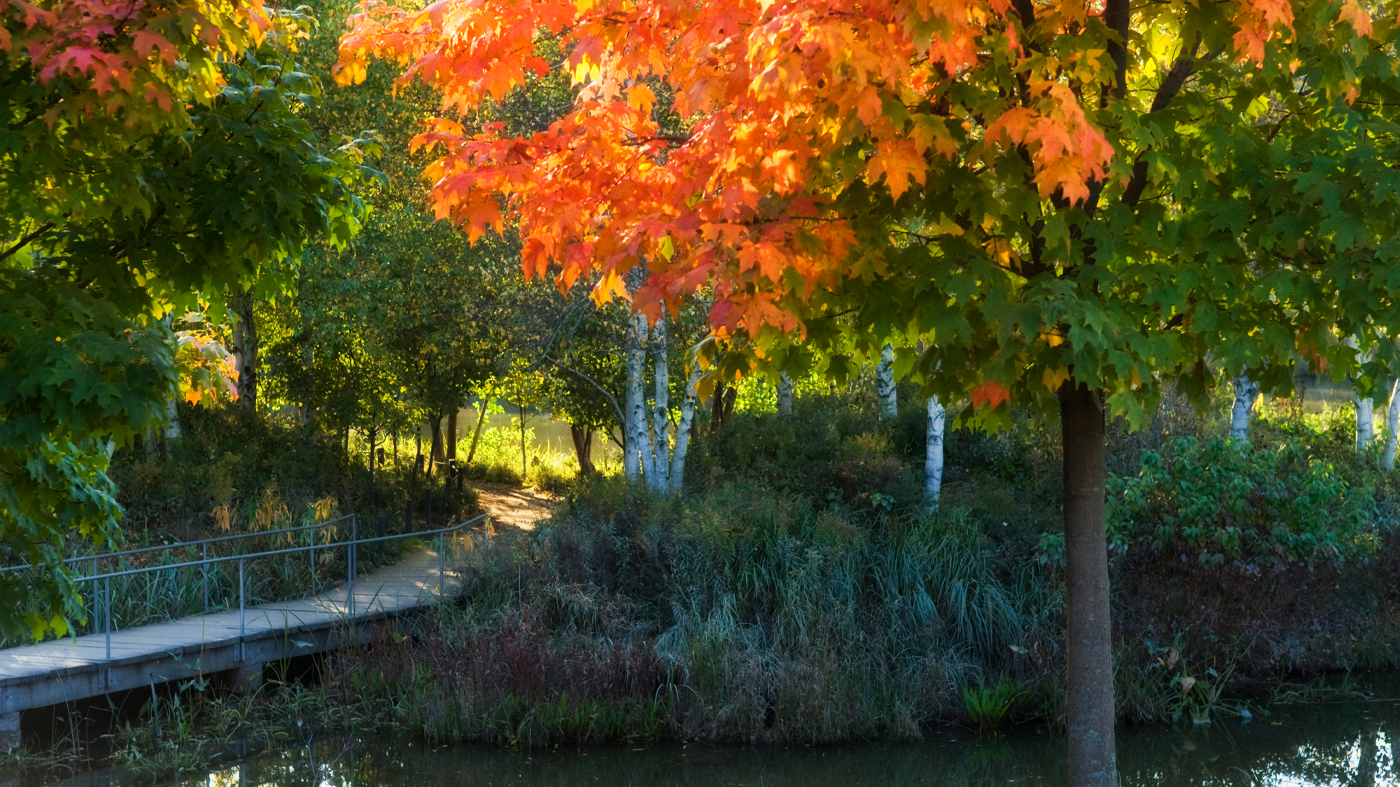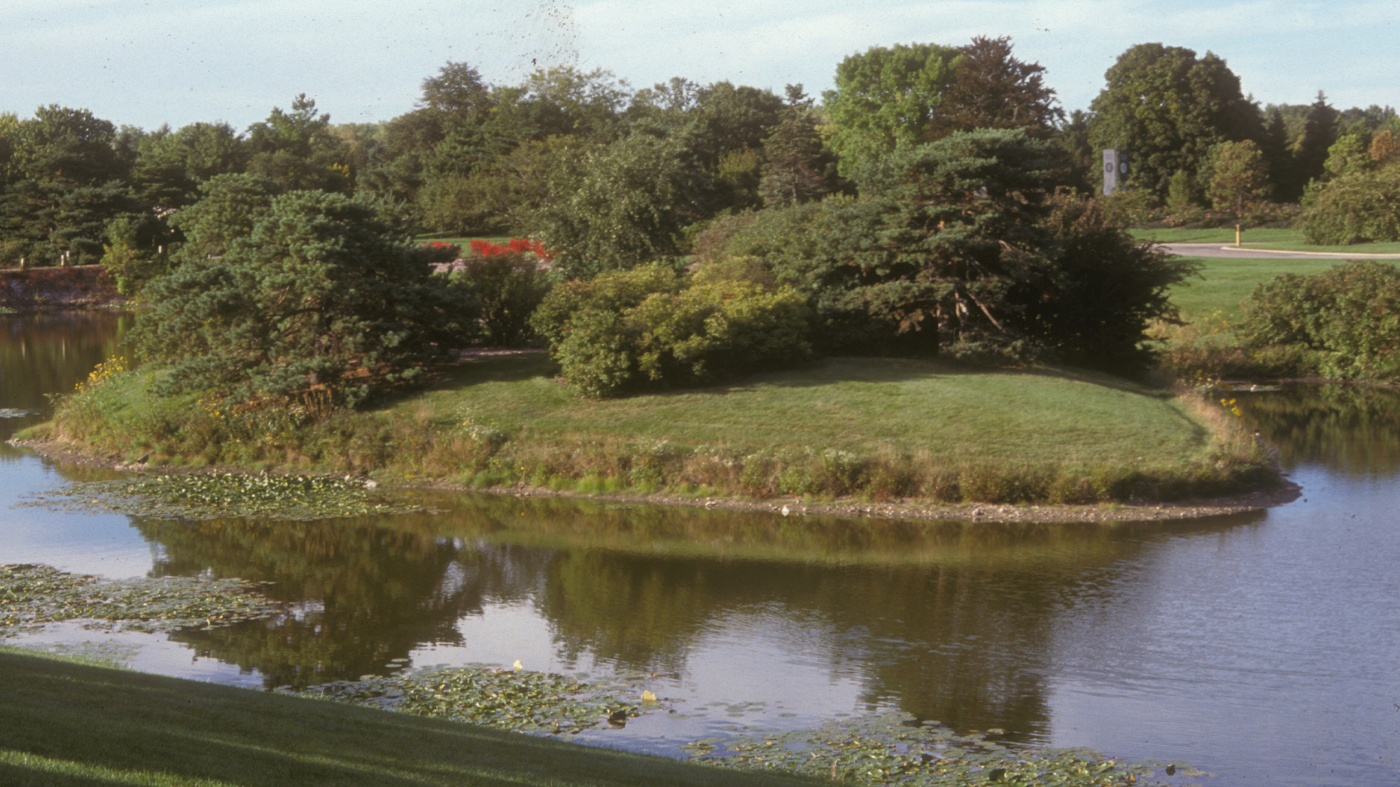Having just celebrated our 50th anniversary Garden-wide, we are quietly marking the "birthdays" of several individual gardens: the Home Landscape, Aquatic, Bulb, Native Plant, Heritage, and Regenstein Fruit & Vegetable Gardens all opened in the summer of 1984.
This got us thinking about the issue of maturing gardens—a topic that every gardener deals with sooner or later. In this issue of Smart Gardener, we offer some thoughts about helping your garden to age gracefully. While a mature, lush, beautifully maintained landscape is every gardener's dream, Mother Nature (and time) aren't always on the same page that you are.
Spider Island before renovation looks overgrown and exhausted. Many original plantings have died out, and existing shrubs are unappealing and unmaintained. Many will stay, but many will be moved to other locations in the Garden.

Spider Island a few years after renovation is a sanctuary of dappled shade and vivid color in the fall, thick with native shoreline plants, which add a lush texture to the landscape while preventing erosion.
Are portions of your landscape already showing signs of age?
Perhaps it's fully grown trees that have turned your sunny yard into a shady one. Shrubs gone wild after a season or two of missed pruning. Hedges revealing bare spots as some evergreens "age out" before others. (The latter happened to us recently in the Home Landscape garden.)
Or perhaps it's yard/garden structures that are showing the passage of time. Mortar crumbles and bricks tumble. Sidewalks and slabs tilt as tree roots flex their might. Wooden structures cry "uncle" after decades of service. (This spring, our carpentry crew rebuilt —beautifully—the wooden pergola/arbor in the Regenstein Fruit & Vegetable Garden.)
Sound familiar?
Then it's time to become the curator of your own garden. Just as the curator of an art gallery or museum edits, fine tunes, and monitors a collection as it grows and ages, so may a home owner approach the elements in his/her garden.
Start with a fresh eye
The first step is to go outside, walk around your property, and take a good look at what's going on. Stand back and look at the overall composition of your yard: overgrowth happens slowly, and landscapes change incrementally each year. How does yours make you feel? Do you wish it was sunnier? Simpler? More colorful? Are you craving more privacy, or feeling claustrophobic? Think about the goal for your garden and curate toward that goal.
Make a simple map
A basic layout of your space (including key measurements) will prove invaluable for reference over time, whether you use garden-planning software or a simple piece of drawing paper and a few photos. Draw in your hardscape elements: structures and paths, water features and light fixtures, large trees and hedges, and the outlines of beds.
List and assess
Next, create a working list of each landscape plant and hardscape item, noting age (if known), location (sunny spot? under the downspout? surrounded by concrete?) and overall health or condition. Work from the top down (trees and tall items, shrubs and medium-sized features, perennials, bulbs, annuals). For plants, indicate where diseases or pests are a problem and where a better cultivar might be an improvement. For structural elements, note where repairs/replacement are necessary.
Rate and rank
Now ask yourself the difficult questions: Has your favorite shrub overwhelmed the rest of the bed? Did that pretty accent plant turn out to be invasive? Can the garden gate last one more year, or is it maintenance time?
Use your garden map and assessment list to rate and rank the issues in your yard. Think of your ranking as a plan for updating the yard, a few chores at a time. Work in phases so you can budget in advance.
Consult the experts
Some issues may require outside help: call a pro for infrastructure repairs like brickwork and tuckpointing (they'll match the mortar correctly) or major carpentry work.
Mature tree questions? Consult your local forester or arborist first, and request an on-site visit. Their expertise and knowledge of the neighborhood "forest" will give you fresh insight into your tree's issues.
Pruning can work magic on an aging yard. Hard pruning—reducing by half, or even down to the ground—can restore/renovate many deciduous shrubs. If you've decided to handle pruning yourself, classes for every level of expertise (including Basic Pruning for Homeowners) are offered through the Joseph Regenstein, Jr. School of the Chicago Botanic Garden; check out our current classes here.
The master gardeners at our Plant Information Desk are always happy to discuss the issues of an aging garden; you can even send them questions online here.
Build scenarios toward a master plan
No one can revitalize an aging garden in just a year's time—it's a process. As you prune, remove, transplant, or start afresh, you'll have many opportunities to tweak, re-think, and revise. All are possible scenarios; add those ideas to your assessment list and review them during a winter planning session. Even a simple idea (vegetables mixed in with flowers? an archway of roses? no more lawn?) can become the centerpiece of a yard or garden over time.
To curate is to choose carefully, to organize meaningfully, and to have the courage to edit. By becoming your garden's curator and addressing the issues in an organized way, you'll be prepared for the really big, garden-changing decisions to come, such as removing a beloved tree… or planting a new one.
Karen Zaworski is a garden writer and photographer who lives and gardens in Oak Park, Illinois.


